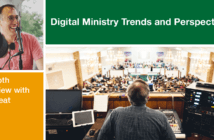Stewardship expert Ken Sloane outlines ideas for making sure that your church’s quarterly giving statements express gratitude and let people know the difference their giving makes, rather than coming across like an impersonal bill or dues statement.
When you open your mail, would you rather receive a bill or a nice, handwritten thank-you note? As we approach the time of year when many churches send their first quarter statement of giving to their congregation, the format of these statements covers a wide spectrum. Some bear a strong resemblance to a bill, while others look as warm and fuzzy as a thank-you note from Grandma after you have sent her that beautiful birthday scarf. I won’t attempt to tell you where your church is – or should be – on this spectrum. However, I offer the following guidelines as you design the format of your church’s quarterly statements.
Everyone wants to feel that they are making a difference. When designing your quarterly statement, consider how a donor’s contribution has made a difference and then tell the story!
1. Make “Thank You” the primary message
Saying “Thank You” is a critical part of your church’s stewardship strategy. This is at the top of my list for a reason. We are human beings, and we respond in a more positive way to thanks and appreciation than to scolding and shame. The quarterly statement can either celebrate the generosity of your donors or make them feel that they have failed to make the mark. The latter will not lead to positive returns when people are approached in subsequent years to set a giving goal.
2. Tell your good stories
Everyone wants to feel that they are making a difference. When designing your quarterly statement, consider how a donor’s contribution has made a difference and then tell the story! Are children being taught about the love of Christ? Were youth provided ministry at a time when they are shaping and forming into Christian adults? What local mission and ministry projects were funded through their generous tithes and offerings? In our society, there is a lot of competition for charitable giving. People want to make a difference and will most often choose to give to organizations that provide compelling stories about how their contributions are making a difference in the world!
3. Make it personal
Computers are wonderful machines. They can print out statements in a fraction of the time it once took. They can even print a scanned signature on each document. But easier is not always better. The more personal you can make the quarterly statement, the better. Having each statement hand signed is great! Handwriting a few words of thanks and then signing is even better!!
4. Don’t do “the due”
There are differing opinions on this one, so here is mine. Never send something from the church that says, “Balance Due” or any variation thereof. I think it is perfectly okay to have a place on the quarterly statement acknowledging and giving thanks for someone’s pledge or estimate of giving. However, just because your software can calculate someone’s shortfall doesn’t mean you should show it. It is like sending a thank-you note to someone for what he or she has done and then adding a post-script saying, “You know you really should have done more.” I would suggest letting the donor do the math.
5. Give opportunities for catch up
Math teachers everywhere will argue with me on this one, but I think churches should send out five quarterly reports each year. Traditionally, quarterly reports are sent in January, April, July, and October. I suggest the addition of a fifth statement in December. An early December report (showing October and November giving, plus a cumulative total from the beginning of the year) gives people encouragement to “get current” with their giving while it can still be counted in the present year. If you wait for this year-end information to be sent in January, it is too late to affect any giving shortfall in previous months.
6. Send an additional acknowledgement for special and large gifts
What size gift warrants a special acknowledgement from the church beyond the statement of giving? The answer depends on your particular context. A $50 gift in some settings would be a large gift, not so in others. Here are some things to consider:
- People who receive a thank you for their first gift are much more likely to make a second gift, so I suggest every donor’s first gift should be acknowledged with a personal letter.
- Gifts given to meet a need above and beyond the budget that is not part of a special appeal should be acknowledged. For example, after the pastor mentions that additional funds are needed to send interested children to camp, a member writes a check to sponsor a child.
- Finally, the IRS specifically says (Pub. 1771) that donors who give single gifts of $250 or more need an acknowledgement from the charitable organization that received the gift. While the quarterly or year-end statement of giving can meet that requirement, it seems to me that $250 might be a reasonable threshold for a donor to receive an additional personalized acknowledgment from the church.
7. Offer an electronic giving option
Finally, if you are not already doing so, offer your congregation the convenience of electronic giving. The cost to the church is small when compared with the benefit of dependable giving whether your donors are present on Sunday morning or not. However, gifts made online should be acknowledged with the diligence and appreciation we’ve discussed for donations made through the offering plate.
This article is adapted from one that appeared originally in “Generous Living” enewsletter, November 2017, issued by Discipleship Ministries of the United Methodist Church.Used by permission.
Related Resources
- Quarterly Financial Statements Enhance Giving by Jennifer And Jim Cowart
- Always Say Thank You by Cesie Delve Scheuermann
- “50 Ways to Encourage Faithful Giving,” a free Lewis Center Resource






